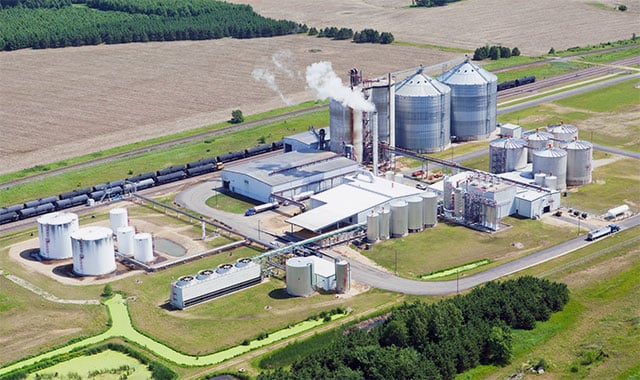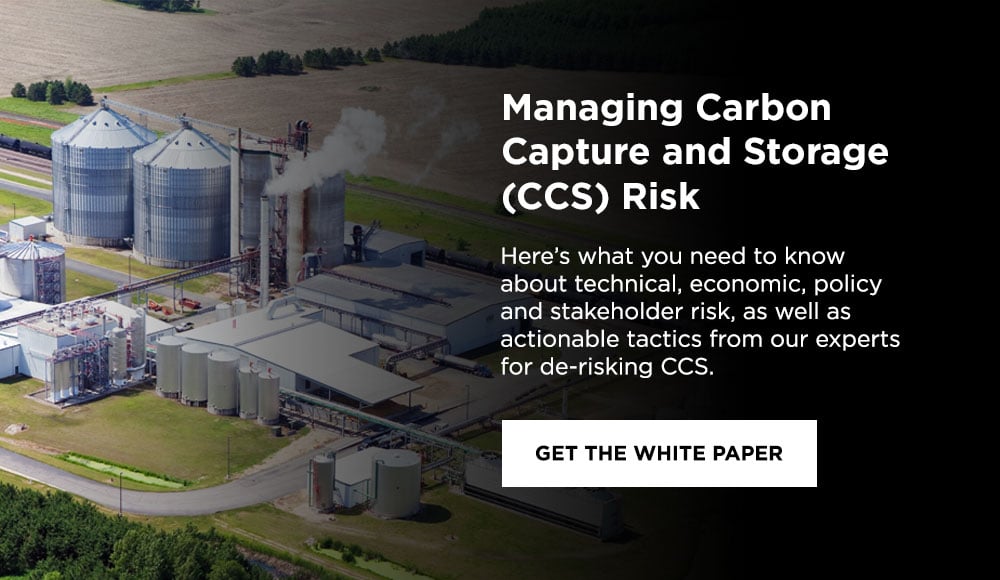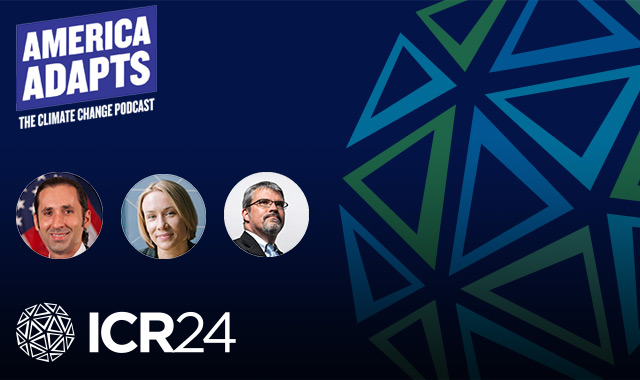3 Essential Tactics to Reduce Carbon Capture and Storage (CCS) Risk

While a promising approach for controlling CO2 emissions, carbon capture and storage does involve a certain amount of risk. However, with a proactive approach to risk management and mitigation, CCS can prove to be an effective, lucrative and viable option.
Keep reading for our Carbon Storage Services experts' top 3 tactics to reduce carbon capture, utilization and storage risk, and download our white paper "Managing Carbon Capture and Storage (CCS) Risk" to learn how to leverage a proactive framework for reducing CCS risk.
What is CCS Risk?
CCS risk is the probability of an unfavorable outcome resulting from a carbon sequestration initiative. Just like any long-term infrastructure venture, all carbon capture and storage (CCS) projects involve some amount of risk.
Types of CCS Risk
Carbon storage risk can be divided into 3 main categories:
- Technical risk
- Economic risk
- Policy/Stakeholder risk
Technical Risk
Technical risks for carbon dioxide storage include factors like maturity levels of CO2 injection and capture technology, lack of expert assistance, and safety.
Economic Risk
Economic risks involved in CO2 storage projects can stem from operational, borrowing, and insurance costs. The stability of project revenue from tax credits and incentives as well as inflation can also introduce economic risk into the equation.
Policy/Stakeholder Risk
Finally, policy and stakeholder CCUS risk consists of political factors like policy stability and regulatory uncertainty as well as acceptance (or non-acceptance) and engagement from community members and other stakeholders.
De-Risking CCS
Although carbon capture and storage involves various kinds of risk, a proactive and comprehensive risk management strategy put in place by subsurface and geotechnical experts can reduce risk or "de-risk" CCS.
Why "De-Risk" CCS?
There are many reasons to implement CO2 storage risk management, including project success and viability, environmental responsibility, and brand reputation.
Let's dive into 3 crucial tactics straight from our CCS experts to help you manage and mitigate CCS risk across the entire lifecycle, from capture and transport to storage and site closure.
Tactic #1: Cross-Chain Risk Management
Cross-chain risk management in the context of carbon capture and storage risk refers to an approach that examines risk across the entire CCS value chain to understand the impact of a decision across all project stages.
Cross-chain risk management for carbon storage projects hinges on these 3 key factors:
- CCS value chain interdependencies
- Technical and economic tradeoffs
- Counterparty risk management
Value Chain Interdependencies
Value chain interdependencies in a CO2 storage project refer to the connection between decisions made in different stages of the CCUS value chain.
Example: Engaging stakeholders like public officials, landowners and community members while planning a geological storage project can increase buy-in as the project progresses, reducing stakeholder risk throughout the entire value chain.
How It Reduces Risk: CCS risk can be reduced by carefully assessing and understanding potential and observed interdependencies and keeping them top-of-mind throughout each stage of an underground storage project.
Technical and Economic Tradeoffs
Technical and economic tradeoffs in the context of carbon storage risk refer to compromises made during CCS project decision-making, to reduce risk for each party involved in the project.
Example: A fossil fuels project developer based in the United States may choose to team with technical or financial partners with specific CCS-related expertise to share the risk (and consequently reduce it for the developer) that is involved in their project.
How It Reduces Risk: CCS risk can be reduced by identifying and analyzing technical and economic tradeoffs and making decisions based on this key information.
Counterparty Risk Management
Counterparty risk management for carbon capture and storage is the management of risk created by integrating counterparties into the CCS value chain.
Example: An oil and gas emitter may decide to enlist a technical partner with specialized expertise in geological formations to manage their CO2 injection site. The technical partner becomes a counterparty and shares the project risk. However, this decision could also introduce part-chain risk to the project if the technical partner doesn't perform as expected.
How It Reduces Risk: CCS risk can be reduced by developing informed strategies for managing risk introduced by counterparties that are involved in any part of the CCS value chain.
Tactic #2: Project Schedule and Budget Integration
In carbon capture, utilization and storage risk, project scheduling and budget integration refers to the examination and optimization of a CCS project's budget and schedule.
Project schedule and budget integration are comprised of these 4 crucial elements:
- Comprehensive project timelines
- Capital expenditure optimization
- Project development sequencing
- Permitting prioritization
Comprehensive Project Timeline
In a CCS project, a comprehensive project timeline refers to a set of clear milestones across the entire carbon storage value chain that aligns with budget considerations and possible permitting obstacles.
Example: An ethanol producer that is obtaining a Class VI permit from the U.S. Environmental Protection Agency can reference their timeline to see if they're on track, or if project risk has the potential to increase.
How It Reduces Risk: CCS risk can be reduced by constructing a full timeline to avoid unnecessary project bottlenecks and corresponding ripple effects as the project progresses.
Capital Expenditure Optimization
Through the lens of CCS risk, capital expenditure optimization is the practice of getting the most out of project expenses through strategic planning and phasing.
Example: A power plant that is implementing geological storage of carbon emissions may optimize capital spend (and thus economic risk) by choosing a single technical partner that can support the project throughout its lifetime.
How It Reduces Risk: CCS risk can be reduced by minimizing project expenditure across the entire carbon capture and storage value chain, including expenses from technical partners, land usage and more.
Project Development Sequencing
For CCS, project development sequencing refers to the step-by-step planning of the development schedules for each stage of a CO2 storage project, from injection to site closure.
How It Reduces Risk: CCS risk can be reduced by sequencing critical data acquisition and site design milestones to ensure the project runs as smoothly as possible.
Permitting Prioritization
In carbon capture and storage risk management, prioritization of permitting activities refers to a focus on obtaining the necessary permits for a CCS project to avoid costly delays.
Example: An ammonia plant that is implementing CCS may choose to hire a technical partner with a proven track record of securing Class VI permits to reduce risk stemming from permit applications.
How It Reduces Risk: CCS risk can be reduced by prioritizing permit applications to alleviate possible setbacks in this crucial stage of the project's lifetime.
Tactic #3: System Design Integration
From the perspective of CCS risk, system design integration involves creating a comprehensive capture, transport and storage system that is flexible and resilient while remaining compliant.
System design integration involves these 3 important components:
- Design flexibility
- Incorporation of redundancy
- Maintaining consistency
Design Flexibility
For CCS, design flexibility is the practice of designing a system that can easily flex to maneuver project setbacks and complications.
Example: A CO2 capture system designed to handle increased CO2 volumes or well workover can reduce the risk of design mitigation or safety events occurring.
How It Reduces Risk: CCS risk can be reduced by utilizing carbon sequestration infrastructure that is designed to minimize issues caused by operational variances and unexpected events.
Incorporate Redundancy
In a carbon capture and storage system, incorporating redundancy refers to including design components that prepare for possible failures or other difficulties.
How It Reduces Risk: CCS risk can be reduced by building operational redundancies to minimize system failures.
Maintain Consistency
In the context of CCS risk, maintaining consistency is the practice of ensuring consistent parameters for CO2 capture, transport and storage throughout the entire value chain.
Example: A CCS system design that ensures proper CO2 requirements are met reduces the risk of non-compliance with regulations, safety protocols and tax credit or incentive requirements.
How It Reduces Risk: CCS risk can be reduced by designing to meet CO2 purity, temperature and pressure requirements, which contributes to smoother operations with fewer setbacks.
Your CCS Risk Management Partner
From navigating potential risks to implementing mitigation strategies, our team of 100+ CCS experts is here to help. We leverage an integrated and strategic risk management process to reduce uncertainty, ensure compliance and optimize project outcomes across the entire CCS value chain.
Count on our 25+ years of CO2 storage experience, comprehensive suite of CCS services and extensive subsurface and geotechnical knowledge to ensure your project's success.
Related Blogs
BATTELLE UPDATES
Receive updates from Battelle for an all-access pass to the incredible work of Battelle researchers.









